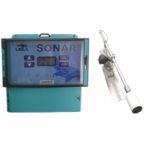Hawk FF Level Series – OSIR-XXXX

Version
01
Registered Product Information
Manufacturer:
Hawk Measurement Systems Pty. Ltd.
Product Name:
Hawk FF Level Series – OSIR-XXXX
Product Description:
ORCA Sonar Level Series
Protocol:
FOUNDATION Fieldbus
Category:
Level
Profile:
FOUNDATION Field Device
More Information:
ORCA - Sonar Bed Level System
Principle of Operation
The ORCA Sonar Bed Level transducer emits a high powered acoustic pulse,
which is reflected from the interface density selected. The reflected
signal is processed using specially developed software algorithms, that
eliminate lighter floating densities and stratified layers, allowing
measurement of "RAS" or "BED" levels. It can be calibrated to measure
lighter densities like "FLOC" or one of the outputs could be used for a
"CLARITY" output, similar to a basic turbidity transmitter measuring
solids in suspension.
By choosing the correct sonar transducer frequency, the ORCA sonar
guarantees the optimized performance when measuring both light and heavy
density interfaces.
Primary Areas of Application
* Sewage & Wastewater
Primary Sedimentation - Blanket level
Secondary and final Clarifiers - RAS Blanket and fluff/pin floc layer
Thickeners and DAF - Bed level and clarity of water
Sequential Batch Reactors - Blanket monitoring (floating sonar)
Lagoons - Bed sludge level
Lamella Clarifier - Bed level and floc level
* Mining / Process
Clarifiers, thickeners, CCD's, settling ponds/lagoons, water treatment,
carbon columns
Features:
* Dual independent analogue outputs to track two different interfaces,
or clarity simultaneously, with the one sonar sensor.
* Full range of sonar transducers to optimize
detection of heavy and light density interfaces.
* Widest range of sonar frequencies to optimize performance.
* Easy calibration to track specific density interfaces. eg: RAS
blanket - 4g/l, floc/fluff layer - 1g/l.
* Industrial scum cleaning mechanisms, that do not require maintenance.
* No wiper blade assemblies.
* Control room graphics of tanks and interfaces.
* Wide range of communications:
Devicenet, GosHawk, HART, Modbus, Profibus DP, Foundation Fieldbus and
Profibus PA
* CDMA/GSM remote support capability for calibration, commissioning or
technical back-up.
* Relay alarms
Registered Product Details
Manufacturer ID (hex):
001988
Device Type ID (hex):
0001
DEV_REV (hex):
01
DD Revision:
0x01, 0x01(DD5)
FOUNDATION Physical Layer Profile:
113 - Standard-power signaling, bus-powered, non I.S.
Stack Manufacturer:
Fieldbus Inc.
FOUNDATION Stack Class:
31PS, 32L
Stack Version:
3.0
Registered Blocks:
1-RB(e), 4-AI(e)
Other Blocks:
1-TB(c)
Registered Features:
Alarms and Events
Function Block Linking
Trending
Registration Information
Registration Authority:
FieldComm Group
Registration Status:
Registered
Tester Version:
5.2.0
DD/CFF Tester Version:
5.2.0
Contact Information
E-mail:
info@hawk.com.au
Website:
http://www.hawkmeasure.com
Device Support File Usage
FieldComm Group (FCG) makes available to its members and to the public certain device driver (DD) files, in various forms, that have passed certain tests conducted by or through FCG. The DD files are, or are created from, submissions to FCG by FCG members and are provided by FCG AS IS. FCG disclaims all liability for the accuracy, suitability or use of the DD files. Each member creating DD files has its own policies regarding supporting use of those files, and may, for instance support use of DD object code files, but not DeviceInfo or other files. While FCG is under no obligation to provide support for use of any DD files, FCG welcomes all inquiries on the subject and will often be able to assist.